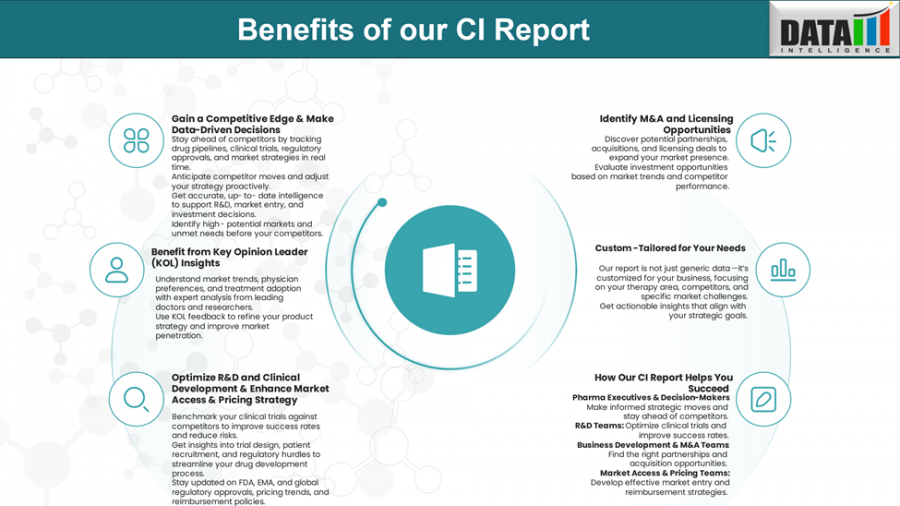
Uveal Melanoma (UM): Charting the Future of Innovation in a Rare Eye Cancer | Competitive Intelligence
Uveal Melanoma enters a new era with novel therapies like KIMMTRAK and HEPZATO, as next-gen treatments aim to overcome immune evasion and metastasis.
AUSTIN, TX, UNITED STATES, June 16, 2025 /EINPresswire.com/ -- Uveal Melanoma (UM) is a rare but aggressive cancer originating in the melanocytes of the uveal tract of the eye, which includes the iris, ciliary body, and choroid. Although the primary tumor is often effectively treated with surgery or radiotherapy, metastatic spread, especially to the liver, occurs in up to 50% of patients within 15 years, often with devastating outcomes.
Unlike cutaneous melanoma, UM is biologically distinct, with a low tumor mutational burden and immune-evasive behavior, rendering traditional immunotherapies largely ineffective, until recently.
Download CI Sample Report: https://datamintelligence.com/strategic-insights/sample/uveal-melanoma
Approved Therapies for Uveal Melanoma
1. KIMMTRAK® (tebentafusp-tebn) – Immunocore
• FDA Approval: 2022
• Mechanism: Bispecific T-cell receptor therapy targeting gp100 peptide-HLA-A*02:01 and CD3 on T-cells.
• Indication: HLA-A*02:01-positive adult patients with metastatic or unresectable UM.
• Impact: KIMMTRAK marked a paradigm shift, being the first and only immunotherapy approved for UM, demonstrating a median OS of 21.7 months vs. 16 months with the investigator’s choice of treatment.
2. HEPZATO KIT™ (melphalan for percutaneous hepatic perfusion) – Delcath Systems
• FDA Approval: 2023
• Mechanism: Delivers high-dose melphalan directly to the liver, minimizing systemic toxicity.
• Indication: Adult patients with unresectable hepatic-dominant metastatic UM.
• Impact: Addresses the liver-centric nature of UM metastasis; approved under an interventional chemoperfusion approach.
Emerging Therapies in the Pipeline
With current treatments limited by HLA-A*02:01 restriction or organ-specific delivery, multiple companies are advancing diverse modalities to improve efficacy, access, and long-term outcomes:
Pipeline Therapies Under Clinical Development (Selected)
1. Tebentafusp (KIMMTRAK) – Immunocore – Phase III
• Now being evaluated in Phase III adjuvant settings to prevent relapse after primary tumor treatment.
2. Belzupacap sarotalocan – Aura Biosciences – Phase III
• A photosensitizer that activates in tumor cells to generate reactive oxygen species. Phase III trials are focused on primary UM to prevent progression.
3. Darovasertib – IDEAYA Biosciences – Phase III
• A PKC inhibitor is entering planned Phase III trials for neoadjuvant use, aiming to shrink tumors pre-surgery and target micrometastases early.
4. RP2 (Oncolytic HSV expressing anti-CTLA-4) – Replimune – Phase II/III
• A next-gen viral immunotherapy combined with nivolumab in Phase II/III, targeting checkpoint-naïve metastatic UM.
5. Roginolisib – iOnctura – Phase II
• A PI3K delta inhibitor under Phase II development for metastatic UM patients, potentially modulating the tumor microenvironment.
6. Cifurtilimab (SEA-CD40) – Pfizer – Phase II
• A CD40 agonist monoclonal antibody, aiming to promote APC activation and T-cell priming.
7. [225Ac]-FPI-1434 – Fusion Pharmaceuticals/AstraZeneca – Phase I/II
• A radioligand therapy targeting IGF-1R, delivering Actinium-225 directly to UM cells. Early-phase trials are ongoing.
8. ONM-501 – OncoNano Medicine – Phase I
• A dual-activating STING agonist in Phase I for recurrent UM, designed to stimulate innate immunity and tumor inflammation.
9. 225Ac-MTI-201 – Modulation Therapeutics – Phase I
• A novel alpha radiotherapy agent targeting MC1R, a melanocytic receptor prevalent in UM cells.
10. Nelitolimod (SD-101) – TriSalus Life Sciences – Phase I
• A TLR9 agonist developed for hepatic metastatic UM, delivered using pressure-enabled infusion.
Market Shifts and Strategic Trends
Key Market Shifts
• From palliative to curative intent: Therapies are moving toward adjuvant and neoadjuvant applications, aiming for early disease control.
• Immune system re-engagement: Strategies targeting innate immunity (e.g., STING, TLR9, CD40) are gaining traction to overcome UM’s immune desert phenotype.
• Precision delivery: Advances in radioligand and liver-targeted systems are enabling focused tumor killing while preserving systemic health.
• Broadening eligibility: With KIMMTRAK’s restriction to HLA-A*02:01 (~45–50% of patients), the pipeline aims for broader population inclusion.
Book Free CI Consultation Call: https://datamintelligence.com/strategic-insights/ci/uveal-melanoma
Target Opportunity Profile (TOP)
To outcompete approved therapies, emerging drugs must demonstrate:
• Broader patient applicability (not restricted by HLA status)
• Superior survival benefit and/or organ-specific control
• Better safety and tolerability
• Mechanistic novelty (e.g., STING/CD40 vs. TCR)
• Convenient delivery (oral, SC, or IV over hepatic perfusion)
• Combination readiness with ICIs, RLTs, or biologics
Conclusion: UM at an Inflection Point
Uveal melanoma has long been underserved with limited treatment options and poor metastatic outcomes. With KIMMTRAK paving the way and HEPZATO offering a liver-specific solution, the stage is now set for next-generation immunotherapies, kinase inhibitors, and precision delivery platforms to transform outcomes.
The future of UM treatment lies in combining innovation, patient-centric accessibility, and mechanistic breadth. The pipeline is rich, but to succeed, emerging candidates must not only be novel but also strategically superior to existing benchmarks.
Read Related CI Reports:
1. Messenger RNA mRNA Vaccine | Competitive Intelligence
2. Idiopathic Pulmonary Fibrosis | Competitive Intelligence
Sai Kumar
DataM Intelligence 4market Research LLP
+1 877-441-4866
sai.k@datamintelligence.com
Visit us on social media:
LinkedIn
X
Distribution channels: Healthcare & Pharmaceuticals Industry
Legal Disclaimer:
EIN Presswire provides this news content "as is" without warranty of any kind. We do not accept any responsibility or liability for the accuracy, content, images, videos, licenses, completeness, legality, or reliability of the information contained in this article. If you have any complaints or copyright issues related to this article, kindly contact the author above.
Submit your press release
